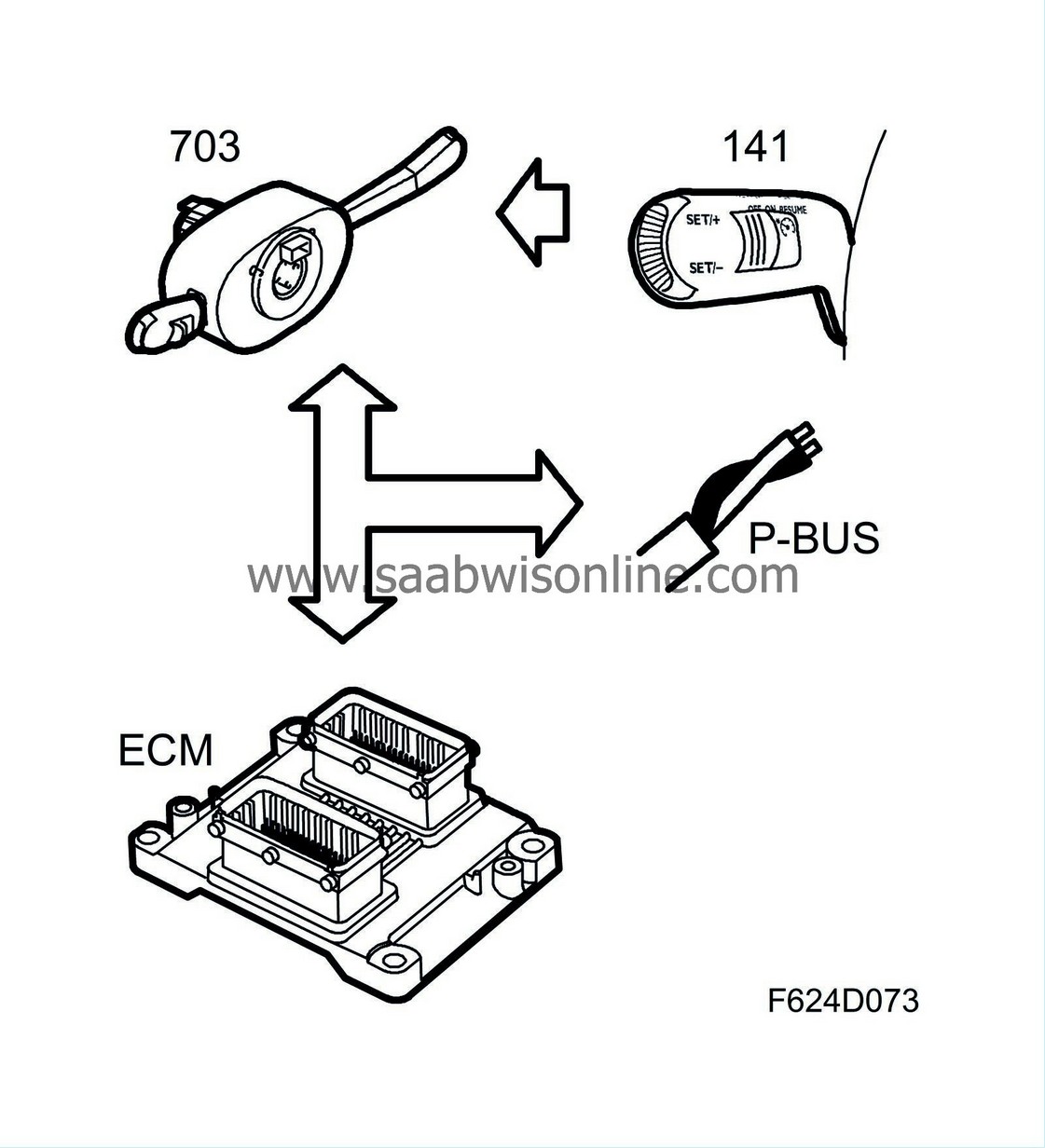Cruise control function
| Cruise control function |
| General |
Cruise control is operated with a switch on the direction indicator stalk. The switch (141) is an integrated part of CIM (703), which sends the position of the switch as bus messages.


ECM then reads from a table containing the nominal rolling resistance on a flat surface at different vehicle speeds. This results in an engine torque request to maintain a constant speed.
Vehicle speed below requested
If vehicle speed is lower than that requested by the cruise control function, ECM will increase the requested engine torque until the vehicle speed is the same as the requested speed. The maximum engine torque that cruise control can request is limited to provide the best comfort. Likewise, the increase in torque is limited to prevent excessive acceleration.Vehicle speed above requested
If vehicle speed is higher than that requested by the cruise control function, ECM will decrease the requested engine torque until the vehicle speed is the same as the requested speed. To provide the best comfort, torque reduction is filtered so that engine torque does not suddenly disappear completely. Note that on steep downward inclines, vehicle speed may exceed that requested by the cruise control function.| Activating cruise control |
Conditions for activation
The following criteria must be fulfilled before cruise control can be activated:| • |
Brake light switch inactive
|
|
| • |
Brake and clutch switches inactive
|
|
| • |
Vehicle speed, front wheel, exceeds 25 km/h
|
|
| • |
Vehicle speed, rear wheel, exceeds 25 km/h
|
|
| • |
Retardation not too rapid
|
|
| • |
Gear engaged
|
|
| • |
Brake pedal pressed before activating cruise control
|
|
| • |
+15 present
|
|
| • |
No active fault codes affecting cruise control
|
|
| • |
TCS/ESP not active
|
|
| • |
Vehicle speed below 200 km/h
|
|
| Note | ||
|
For safety reasons (brake system function), the brakes must be applied once while the engine is running before the system can be activated. If an attempt is made to activate cruise control without testing the brakes, the following message will be shown on SID: Test brakes before activating cruise control. |
Switch positions
| • |
ON
: Engage
|
|
| • |
OFF:
Disengage
|
|
| • |
SET/+:
Set speed and increase set speed
|
|
| • |
SET/-:
Set speed and reduce set speed
|
|
| • |
RESUME:
Resume set speed
|
|
The cruise control indicator in MIU comes on when the slider has been moved to ON. If the engine is turned off with the system on, the system will still be on next time the engine is started.
Setting the desired speed
| • |
Move the slide control to
ON
.
|
|
| • |
Move the control to
SET/+
or
SET/-
when the car has attained the desired speed (above 25 km/h).
|
|
Increasing the set speed
When cruise control is not active:| • |
Accelerate to the desired speed. Move the control briefly to
SET/+
or
SET/-
.
|
|
When cruise control is already active:
| • |
Move the control briefly to
SET/+
, the speed increases 1.6 km/h (1 mph).
|
|
| • |
Hold the control in
SET/+
position until the desired speed is attained.
|
|
To decrease the set speed
When cruise control is not active:| • |
Brake to the desired speed. Move the control briefly to
SET/+
or
SET/-
.
|
|
When cruise control is already active:
| • |
Move the control briefly to
SET/-
to reduce the speed 1.6 km/h (1 mph).
|
|
| • |
Hold the control in
SET/-
position until the desired speed is attained.
|
|
Temporary speed increase
Accelerate without changing down (cars with manual gearbox) such as when overtaking. The set speed will be resumed after releasing the accelerator pedal.Disengage temporarily
Move the slide control to the left towards OFF but only far enough to disengage cruise control. The control will spring back.Re-engaging
Slide the switch to RESUME . The vehicle will resume at the speed that was set earlier. The vehicle speed must be above 40 km/h.Disengaging
The system is disengaged:| • |
As soon as the brake pedal or clutch pedal is depressed (cars with manual gearbox).
|
|
| • |
When the slide control is moved to "Disengage temporarily"
|
|
| • |
When the slide control is moved to
OFF
.
|
|
| • |
When the TCS/ESP system is operating
|
|
| • |
When position N is selected (cars with automatic transmission).
|
|


